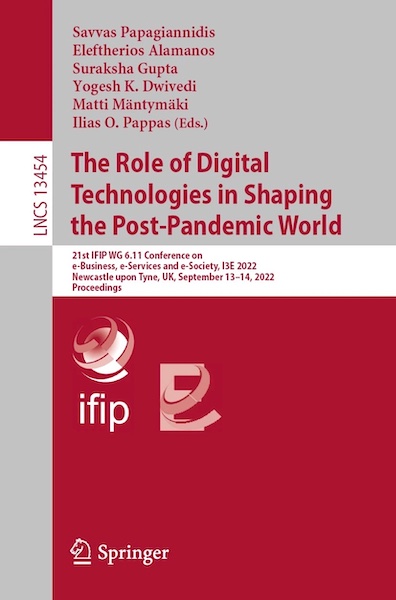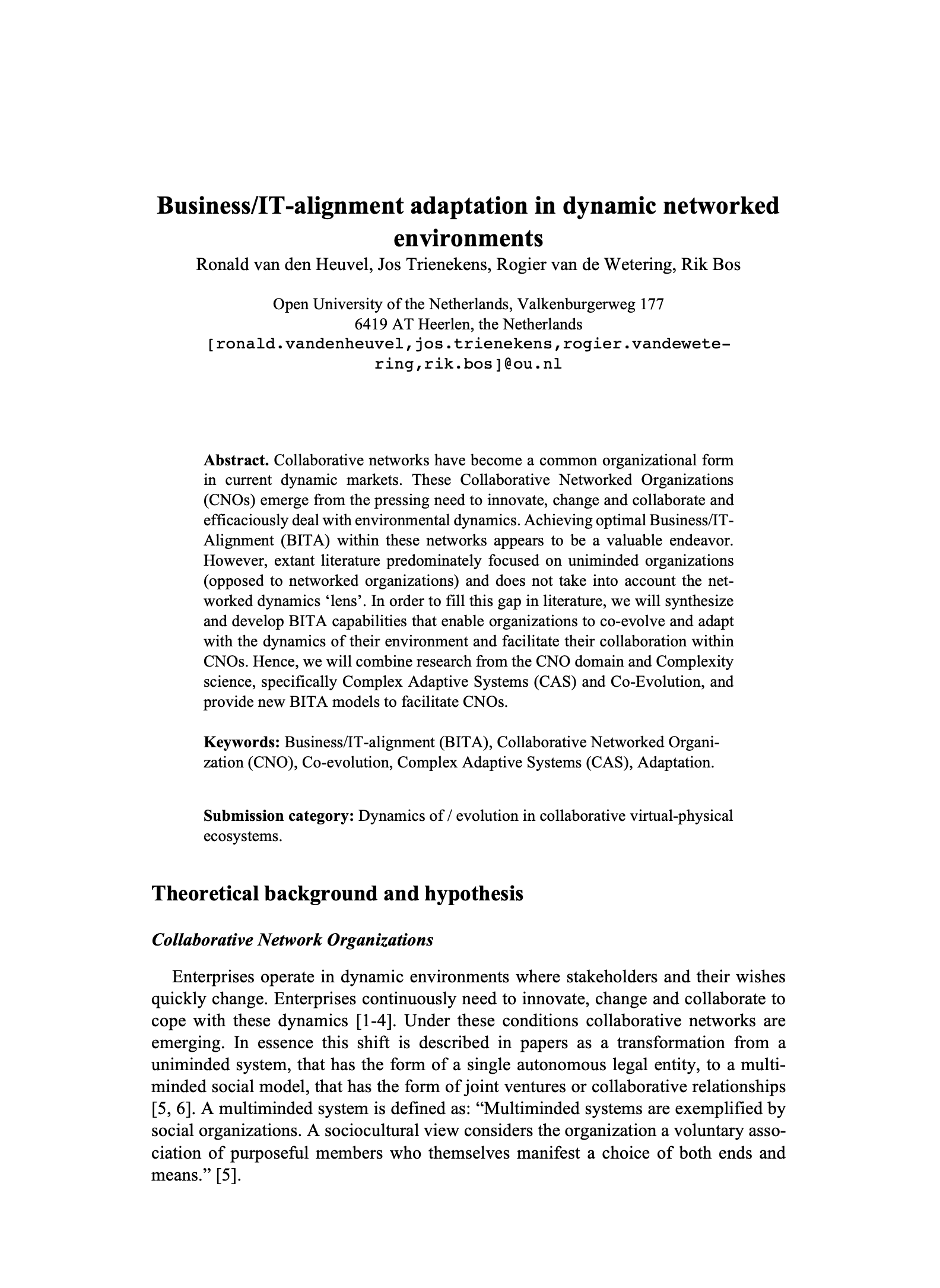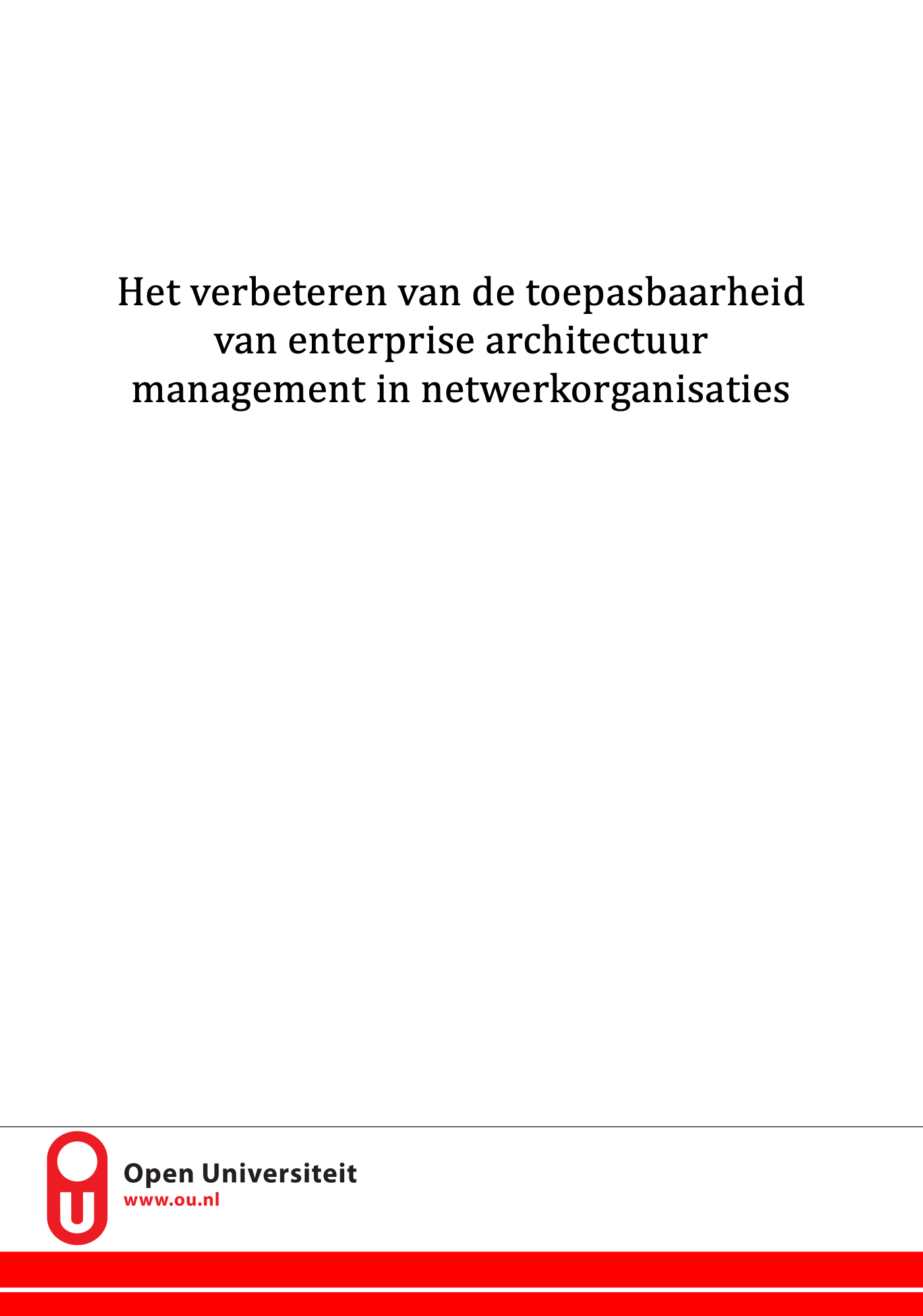Publicaties
De volgende publicaties staan op onze naam. In sommige gevallen kunnen wij de volledige tekst niet online zetten. Mocht u interesse hebben in een van de publicaties, maar geen toegang hebben tot het werk, laat het ons dan gerust weten.
Using Information Technology to Create Sustainable Organizational Constellations
Organizations build alliances to create products or services that fulfill a specific market need. These alliances have been around for a while, and researchers describe them in various terms like Virtual Organization, or Ecosystem. The manifestation of these alliances increased due to the increasing interconnection between organizations within the fourth industrial revolution. The never-ending alignment between markets and alliances provides a dynamic landscape for organizations and their partners. While abundant research is available on these constellations, we do not know what IT needs can be used to cope with these dynamics. Our research aims to fill that gap, specifically on the relations between network participants and their interactions. We executed a multi-case study on 10 alliances comprising 35 interviews, which were transcribed and coded. By analyzing the co-occurrence, we could determine relationships between the organizational characteristics and the IT needs. Our results validated the characteristics framework, provided a list of IT needs, and showed that IT needs can positively influence and strengthen organizations to cope with market dynamics.
van den Heuvel, R., van de Wetering, R., Bos, R., Trienekens, J. (2024). Using Information Technology to Create Sustainable Organizational Constellations. In: van de Wetering, R., et al. Disruptive Innovation in a Digitally Connected Healthy World. I3E 2024. Lecture Notes in Computer Science, vol 14907. Springer, Cham. https://doi.org/10.1007/978-3-031-72234-9_27
The impact of improvisational and dynamic capabilities on business model innovation during COVID-19: a composite-based approach
Dynamic capabilities embody various capabilities that drive the organization’s adaptiveness and are studied from management and information systems perspectives. However, the impact of specific dynamic and organizational capabilities, i.e., management system adaptability and improvisational capabilities, on business model innovation under tumultuous times still has to be unfolded. Therefore, this study investigates the role of these capabilities during the COVID-19 crisis. This study presents the results of analyses on obtained survey data (N = 105) from Ghana and shows that these two strategic capabilities significantly influence business model innovation. Also, this study shows that business model innovation positively influences organizational performance under COVID-19. These results extend the current knowledge base of dynamic and organizational capabilities while offering implications for practice. We also offer various practical recommendations that help overcome business model innovation challenges during tumultuous times.
van de Wetering, R., Doe, J., van den Heuvel, R., & Al Halbusi, H. (2022). The Impact of Improvisational and Dynamic Capabilities on Business Model Innovation During COVID-19: A Composite-Based Approach. In Conference on e-Business, e-Services and e-Society (pp. 422-433). Springer, Cham.
How Distributed Ledger Technology Can Influence Trust Improving Data Sharing in Collaborative Networks
Collaborative networked organizations (CNOs) strive to achieve a common goal. Collaboration within CNOs relies on information technology (IT) and trust. Trust appears in different forms, such as relational, contractual, and competence trust that strengthens the relationships. In addition to trust, data sharing is fundamental to CNOs, as it can improve business-to-business transactions. In this paper, we show how distributed ledger technology (DLT) can increase trust and improve data sharing. We created a decision model, using a design science research (DSR) approach, that provides a mapping between DLT-characteristics and trust antecedents in order to select appropriate DLT. We use an analytic hierarchy process (AHP) approach to establish the trust antecedent ranking within the CNO for European law enforcement (ELE), Europol and its operational partners. Our research provides an evaluated model to determine the DLT-characteristics that can increase trust and data sharing in a CNO.
van den Heuvel R., van de Wetering R., Kruidhof O., Bos R., Trienekens J. (2021) How Distributed Ledger Technology Can Influence Trust Improving Data Sharing in Collaborative Networks. In: Ceci F., Prencipe A., Spagnoletti P. (eds) Exploring Innovation in a Digital World. Lecture Notes in Information Systems and Organisation, vol 51. Springer, Cham. https://doi.org/10.1007/978-3-030-87842-9_6

Symposium on Learning and Innovation in Resilient System 2019: How Distributed Ledger Technology Can Influence Trust
Identification of IT-Needs to Cope with Dynamism in Collaborative Networked Organizations – a Case Study
Collaborative Networked Organizations (CNOs) are increasingly com- mon in current dynamic markets. The participants in a CNO try to achieve a com- mon goal while acting on market opportunities. Information technology (IT) fa- cilitates collaboration between participants within a CNO. In this paper, we show how CNOs cope with network-dynamics related to their IT-needs. Two sub-char- acteristics of network dynamics, respectively many-to-many relations and inter- action patterns, will be investigated. In the end, we are trying to answer the ques- tion regarding what IT-needs CNOs have, to cope with CNO-dynamism. Based on a literature review we developed a framework on CNO-dynamism and exe- cuted a multi-case study within four CNOs. We conclude that all framework com- ponents are recognized within the CNOs. CNOs appeared to mainly cope with dynamics by using collaborative platforms, task management systems, and con- ference facilities.
van den Heuvel, R., van de Wetering, R., Bos, R., & Trienekens, J. J. M. (2020). Identification of IT-Needs to Cope with Dynamism in Collaborative Networked Organizations—A Case Study. In R. Agrifoglio, R. Lamboglia, D. Mancini, & F. Ricciardi (Eds.), Digital Business Transformation: Organizing, Managing and Controlling in the Information Age (pp. 219-236). Springer Nature Switzerland AG. Lecture Notes in Information Systems and Organisation Vol. 38 https://doi.org/10.1007/978-3-030-47355-6_15

Symposium on Learning and Innovation in Resilient System 2017: Business/IT-alignment in dynamic networked environments
Toward CNO Characteristics to Support Business/IT-Alignment
Increasing market dynamics rapidly change the business landscape. Collaboration amongst organizations is a common way to cope with these dynamics. Achieving a state of Business/IT-alignment (BITA) within Collaborative Networked Organizations (CNOs) appears to be a valuable endeavor. Therefore, this paper investigates CNO characteristics, as a basis, to incrementally design BITA artifacts that facilitate CNO-dynamism. Via a structured literature review and an expert session, we synthesized a list of 6 main and 22 sub-characteristics for CNOs. This list provides more detailed characteristics than we found in the literature. We also discuss the importance of the characteristic “Dynamic and self-regulating network” and the need for new BITA models that can cope with the dynamics.
van den Heuvel R., Trienekens J., van de Wetering R., Bos R. (2017) Toward CNO Characteristics to Support Business/IT-Alignment. In: Camarinha-Matos L., Afsarmanesh H., Fornasiero R. (eds) Collaboration in a Data-Rich World. PRO-VE 2017. IFIP Advances in Information and Communication Technology, vol 506. Springer, Cham. https://doi.org/10.1007/978-3-319-65151-4_41
Business/IT-alignment adaptation in dynamic networked environments
Collaborative networks have become a common organizational form in current dynamic markets. These Collaborative Networked Organizations (CNOs) emerge from the pressing need to innovate, change and collaborate and efficaciously deal with environmental dynamics. Achieving optimal Business/IT-Alignment (BITA) within these networks appears to be a valuable endeavor. However, extant literature predominately focused on uniminded organizations (opposed to networked organizations) and does not take into account the networked dynamics ‘lens’. In order to fill this gap in literature, we will synthesize and develop BITA capabilities that enable organizations to co-evolve and adapt with the dynamics of their environment and facilitate their collaboration within CNOs. Hence, we will combine research from the CNO domain and Complexity science, specifically Complex Adaptive Systems (CAS) and Co-Evolution, and provide new BITA models to facilitate CNOs.
van den Heuvel, R., Trienekens, J. J. M., van de Wetering, R., & Bos, R. (2016). Business/IT-alignment adaptation in dynamic networked environments. Poster session presented at 17th IFIP WG 5.5 Working Conference on Virtual Enterprises , Porto, Portugal.
Het verbeteren van de toepasbaarheid van enterprise architectuur management in netwerkorganisaties
Enterprise Architectuur (Management) (EA(M)) is een onderzoeksgebied dat vanaf 2003 meer aandacht krijgt, maar nog erg versnipperd is (Simon, Fischbach, & Schoder, 2013). Het richt zich op het creëren van raamwerken, operationalisering van EAM en modelleringstechnieken (T.-Y. Kim, Lee, Kim, & Kim, 2006). Dat EAM toegepast wordt in grote organisaties, dat het baten levert in de vorm van flexibiliteit en kostenreductie is vanuit de literatuur onderbouwd (Aier, 2014; Boucharas, van Steenbergen, Jansen, & Brinkkemper, 2010b; Hauder, Roth, & Matthes, 2013; Plessius, van Steenbergen, & Slot, 2014). Echter lijkt de focus altijd op enkelvoudige organisaties te liggen. Nieuwe organisatievormen zoals netwerkorganisaties lijken beperkt gebruik te kunnen maken van de bestaande EAM raamwerken, maar hebben potentieel wel baat bij EAM. Netwerkorganisaties bestaan uit zelfstandige organisaties die gezamenlijk werken aan een bepaald doel of een dienst, waarbij de organisatievorm een korte levensduur heeft en participanten competenties en risico’s delen. Netwerkorganisaties winnen aan populariteit door de behoefte aan synergievoordeel om in te spelen op de snel veranderende markt (Camarinha-Matos & Afsarmanesh, 2012). Juist bij deze verandering, waarin IT een belangrijke rol speelt, kan EAM uitkomst bieden.
van den Heuvel, R. (2015). Het verbeteren van de toepasbaarheid van enterprise architectuur management in netwerkorganisaties (Master's thesis, Open Universiteit, Heerlen, The Netherlands)







